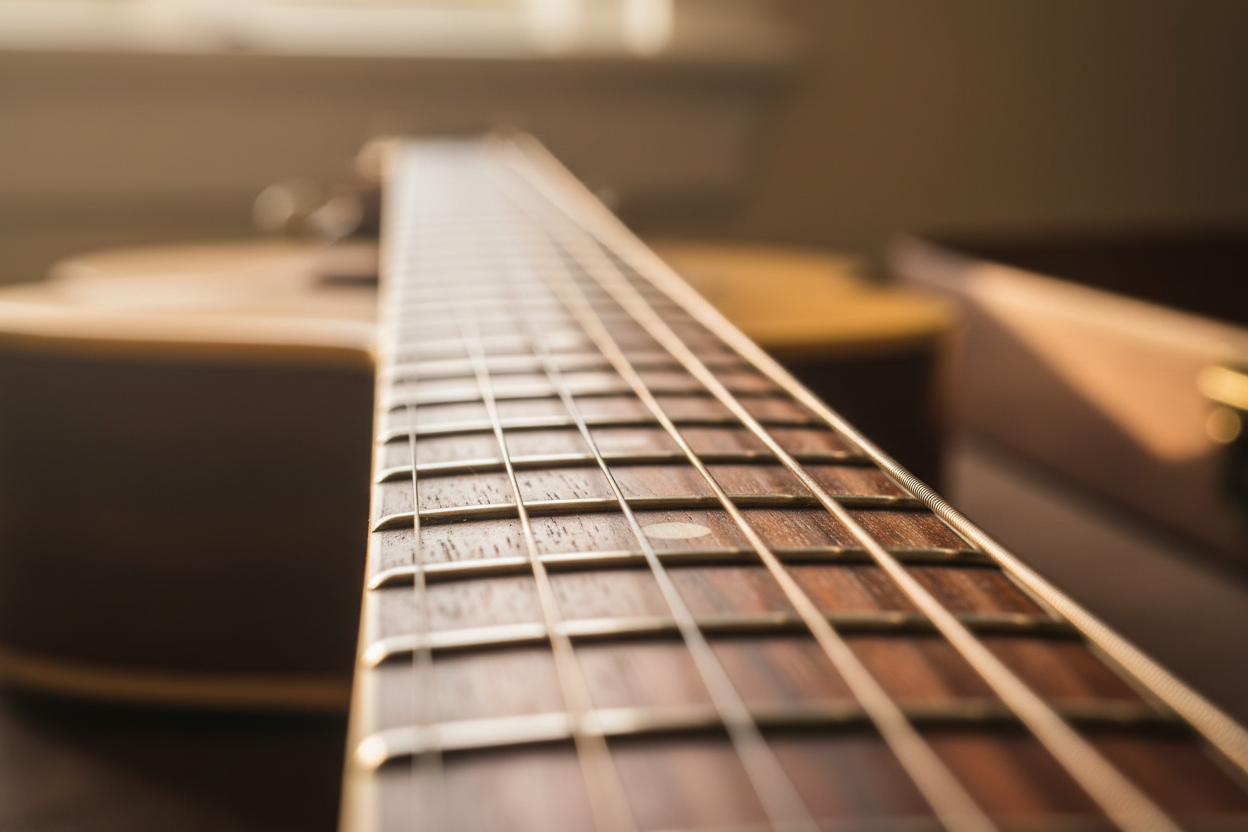Here, we’ll go in-depth on what you should know about guitar strings so you can easily figure out what fits you best, and what to look for, try out, and avoid.
Guitar Strings by Guitar Type
There are three types of strings divided into the three most common guitar types – electric guitar strings, acoustic guitar strings, and classical guitar strings.
Electric guitar strings have to be full-metal to produce a magnetic field strong enough that the pickups can catch it. The most common are steel and nickel-plated strings.
Acoustic guitars are softer and gentler than electric guitars, and the strings work slightly differently. The most common strings for acoustic guitars are bronze, or brass, and their variants. However, if it’s 4 am and you have some classical guitar stings with you, they could do the job until you get the replacements.
Classical guitars are considered the softest, and they can’t carry steel string tension for long or the neck bends. This is why nylon is used as a base, or silk for lower strings.
Parts of Guitar Strings
Though guitar strings are not heavy machinery, we can break them down into two to three parts by which they can be distinguished, and which affect their tone on a guitar.
Core
You’ll notice the difference between the thin and thick strings on your guitar. While high-pitch strings look like a wire strung across your guitar’s neck, the low-end strings have windings. Beneath the winds rests the string’s core, and it can be made of different materials, depending on the purpose.
The most common material for string cores is steel, followed by nylon. Other cores can be made of silk, and you could rarely find “catgut”, the strings made of livestock intestines, like on violins.
While steel cores produce the most tension and brighter sound, they are generally harder to press and are limited to acoustic and electric guitars.
They come in two variations – hex and round. Hex (by cross-section) is now most common since it helps machine winding of the outer layer, while round cores are not as common and usually hand-made. Hex is generally brighter than round.
As for nylon, silk, and catgut, they can be used by acoustic guitar players, and are the only options for classical guitar players. Catgut is the traditional and now mainly abandoned type of string since it's hard to mass-produce. Silk and nylon are more elastic and don’t put much tension on the gentle structure of classical guitars, better for finger-picking, and they are responsible for the distinct dimmer, more buzzing sound of a classical guitar.
String Plating
The three lower strings need additional thickness and people quickly found that increasing core diameter won’t do the trick. This is why these strings are plated with metal, providing thickness while reducing the string’s flexibility and tension. The most common and popular choices for this are steel, nickel, or alloys.
Steel plating is usually found on electric guitars. This is great because it brings almost everything a guitar player needs. Steel is less corrosive so the sound doesn’t change for long, and the tone is bright, it has sustain, and great attack.
While other metals (titanium, copper, cobalt, etc.) bring out this or that in the string’s specs, they are considered highly specialized, hard to find, and beginners especially won’t appreciate the differences as much.
However, nickel plating is the most common across guitars. Nickel is more elastic and easier to work with, which reduced the cost of manufacturing. However, it is more corrosive and these strings should be replaced more frequently, most commonly after a couple of weeks.
On acoustic guitar, you can get 80/20 or 85/15 bronze (copper and zinc). These strings ring well and provide a bright acoustic-y sound. The downside is that the strings get dull and change the sound after a couple of hours to a day of playing, so they are good for concerts and similar one-time plays.
Adding phosphorus to the mix prolongs their life greatly, yet the sound appears dimmer overall. It’s great for enthusiasts playing and practicing for weeks on end. They should also be replaced after a couple of weeks, a few months at most.
Winding
The shape of the plating and how the strings are wound can come in three variations.
The most common is the roundwound, easy to grab and producing more vibrations throughout the strings (we thank this for having to mute the strings so much). Most players, especially if they’re going for rock, blues, pop, or metal, don’t have to look further.
Flatwound plates the strings with a flat tape of metal. It’s not great for bending, but very good for sliding down the neck. These are favorites of some jazz players.
Finally, there’s the halfround, a sort of a hybrid between the two, that doesn’t go as dim as the flatwound, yet is still hard to play and the least common of the three.
String Coating
Some manufacturers coat their strings with different polymers that prevent corrosion and bring longevity at the cost of losing high-end sound, less string sound overall (they’re elastic and don’t buzz as metal), and dimming the strings' sound for a little or more.
The two most common types are Nanoweb, a thinner and more expensive coating, and polyweb, which adds a thicker layer to the metal further dulling the sound (doesn’t have to be a bad thing, depends on what you’re looking for).
Gauge and Tension
Picking the string type is not the end, the string diameter should also be considered. For electric and acoustic guitars, we are talking about gauges, and for classical guitars, this is called tension.
Gauge for electric and classical guitars determines how thick your guitar string will be. This is highly standardized and there’s a limited number of options, 5-6 for acoustic guitars and 7 for electric guitars.
The gauge is measured by a thousandth of an inch (0.00X), and string packaging usually contains the gauge of the high-E and low-E strings. People usually rely on the high-E value when purchasing. That is, for acoustic guitars 0.009-0.014, and electric 0.008-0.012, though you can find several variants among the 0.010 and 0.011.
Another categorization is different variations of light/extra light to heavy/extra heavy.
As for classical guitars, the tension is usually determined by the simple light, medium, and high tension distinction.
The difference in gauge/tension will determine how hard you need to press or bend the string, as well as the brightness and the intensity of the attack. High gauge and high tension strings give shinier and louder tones, while players have to get used to how hard they have to press them. This can produce cramps and tardiness fast for beginners.
In Conclusion
So, what are the guidelines when picking the strings for your guitar? The beginning is pretty straightforward – the type of guitar itself narrows the choice by a lot. Next, you would need to check if you are looking for a brighter tone with lots of high ends, or you’d prefer to stick to lower-end overtones. You should also see if you want to go for longevity and trade off some of the high-end overtones for that.
Finally, you then start thinking about the gauge/tension. If you are just starting, you don’t want to be distracted by finger and hand pain from playing thicker strings, and let your hand gradually get used to it – technique and ability to play songs are much more important for you at this stage.
However, as you gain more strength in your neck hand, and fingers, you can start replacing the strings gradually with thicker ones, just to check if this is something you’d prefer. These various thicknesses are there because every one of them has a fan who sticks to them and develops their playstyle on them.




